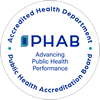
Health
Ticks
Get information on diseases that ticks spread in La Crosse County and how to prevent them.
We track illnesses caused by tick bites in La Crosse County. While we do not identify ticks, there are organizations that do.
Why are we concerned about ticks?
There are a number of illnesses spread by ticks in Wisconsin that are spread by bites from infected ticks. These diseases are common. Not all ticks spread disease and you won't get sick from all tick bites.
Ticks are most active in spring, summer, and early fall. These are the times when people are outside a lot and could be bitten. Wisconsin winters are becoming milder. This creates a longer active tick season and increases your chance of getting a tickborne disease.
How ticks spread disease
Most tickborne diseases in Wisconsin are spread by the black-legged tick, also known as the deer tick. Deer ticks are very small (nymphs are the size of a poppy seed and adults are the size of a sesame seed.)
Ticks feed by biting skin. While they are attached to skin, disease can be spread. Once attached, they usually feed for 3-5 days. Usually it is the nymphs and adult females that spread most tickborne diseases.
Ticks live in natural areas with trees, bushes, or high grass. They can't jump or fly. They crawl onto you or your dog when you brush against leaves or grass.
Tickborne illness and symptoms
Early symptoms of tickborne diseases can happen from 3 to 30 days after a bite from an infected tick. Lyme disease often starts with a rash that looks like a bullseye around or near the tick bite. Not everyone gets that kind of rash, and sometimes you do not even see a tick on your body. If you do see a bullseye rash, call your healthcare provider.
Symptoms of tickborne illness include:
- Fever
- Rash
- Chills
- Headache
- Fatigue
- Muscle or joint aches
- Swollen lymph nodes
If you've spent time outside and have symptoms, talk to your healthcare provider, even if you haven't seen a tick on your body or a rash. You should have a complete recovery if you start antibiotics as soon as possible. If tickborne diseases are not treated, they can be serious and sometimes fatal, even in healthy people.
What you can do to prevent tick bites
Preventing tick bites is the best way to stay healthy.
- Avoid areas where high grass, leaves, trees, and other vegetation touches your clothes, and walk in the center of trails.
- Use EPA-registered insect repellents on exposed skin and clothing. Follow instructions carefully.
- Use products that contain permethrin on clothing, carefully following product instructions.
- Tuck pant legs into socks, and shirts into pants.
- Do a tick check of your whole body every day, even if you were only in your backyard.
- Remove ticks promptly with a tweezer by holding the tweezers close to the tick’s head and pulling upward with steady pressure. Ticks can be as small as a poppy seed or sesame seed. It’s important to remove ticks completely, and as soon as possible.
- Shower or bathe as soon as possible after you've been outside.
- Tumble clothing you’ve worn on high heat in a dryer to kill any ticks on clothing.
Ticks and pets
Dogs are very susceptible to tick bites and the diseases they cause. Tick prevention products should be used on dogs regularly and do tick checks daily. Remove the tick right away. If a tick comes into the house on a dog, it could bite another pet or person living in the house.
Preventing Ticks on Your Pets | Lyme Disease | CDC
Tick bites on dogs can be hard to spot. Look for ticks:
- In and around ears
- Around eyelids
- Under the collar
- Under the front legs
- Between toes and the back legs
- Around the tail
Symptoms of tickborne diseases may take 7 to 21 days to show. Call your vet if your dog has behavior or appetite changes.
Cats are very sensitive to tick prevention products. Talk to your vet before using them.
Resources

Health Department Office Location
2nd Floor, 300 4th St. N.
La Crosse, WI 54601
Main Business Phone: 608-785-9872
Main Fax: 608-785-9846
Email:
[email protected]
In a public health emergency call 911
If you need assistance to access or use information on this website or Health Department services, please let us know
Interpretation services available upon request
Tell us how we are doing! Customer Satisfaction Survey
Office Hours: 8:00am to 4:30pm Monday-Friday; some service hours may vary
Collaboratively promoting a healthful community for all people.
La Crosse County Health Department complies with applicable Federal civil rights laws
and does not discriminate on the basis of race, color, national origin, age, disability, or sex.

